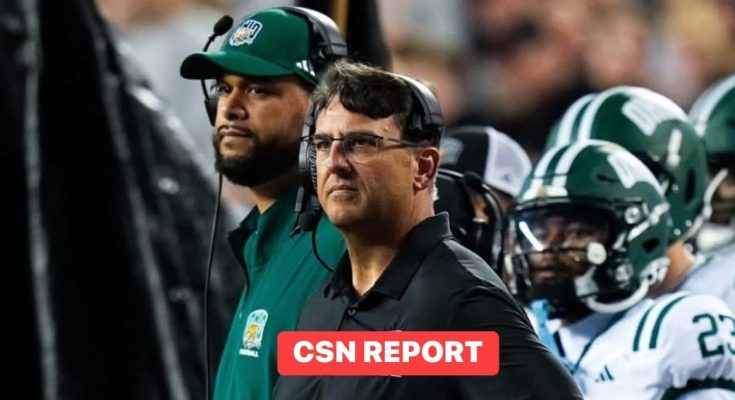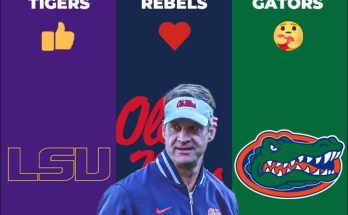In a hard‑fought game Saturday night in Columbus, the Ohio Bobcats fell to the No. 1 ranked Ohio State Buckeyes by a score of 37‑9. Though the result was not what Ohio was hoping for, head coach Brian Smith came away encouraged—not only by his team’s defensive effort, but by what he saw as evidence that the Bobcats are building toward something more durable. What follows is a look at the game, Smith’s praise for the defense, and why he remains confident in the program’s future despite the loss.
Ohio went into the contest with the expectation that it would be asked a lot up front. The Bobcats, representing the Mid‑American Conference (MAC), have already faced two Power Four opponents this season, losing narrowly to Rutgers and eking out a win against West Virginia. Ohio State, meanwhile, came in undefeated, with momentum and high expectations. The game was never going to be easy, but Ohio showed enough flashes early to give hope that this might not be a blowout from start to finish.
Early in the game, the Bobcats’ defense showed toughness. They forced Ohio State into situations where they couldn’t just run away with the offense, especially in the first half. Ohio limited the Buckeyes’ passing attack in several stretches, broke up passes, created pressure, and even forced turnovers. Interceptions by defensive tackle Austin Mitchell and cornerback Michael Mack stood out. Adonis Williams Jr., a senior safety, led in tackles with nine solo stops, and defensive lineman Anas Luqman added Ohio’s lone sack.
Coach Smith emphasized how hard his defense played. While he acknowledged that the scores piled up in the second half, he was particularly proud of the grit his unit showed, especially when Ohio State drove toward the end zone or tried to build momentum. The Bobcats didn’t give up easy yards. They made Ohio State work. They made them respect their front, their linebackers, and their secondary.
Despite these positives, several things went wrong. Offensively, Ohio couldn’t sustain many drives, and when they did, penalties, missed opportunities, and an inability to finish – especially in the red zone – hampered them. The Buckeyes, led by quarterback Julian Sayin, piled up big plays in the passing game—connecting on several deep throws and exploiting mismatches. Sayin threw for 347 yards and three touchdowns, spreading the ball among multiple receivers. Also, Ohio’s run defense, while good in the first half, eventually gave way, especially as Ohio State opened up some of its outside run/option‑type plays and trick‑action passes, stretching the field.
The turning point came just after halftime, when Ohio cut the lead to 13‑9 on a 67‑yard touchdown pass from Parker Navarro to Chase Hendricks. For a moment, momentum seemed possible. Instead, the Buckeyes responded, putting together several long drives, scoring touchdowns and field goals, and steadily pulling away. Ohio State’s offense seemed to find its rhythm, and Ohio’s defense—though still battling—had less margin for error.
After the game, Smith was forthright about disappointment with the final score but insisted that he saw something in his players that gives him belief going forward. “A lot of our guys are disappointed in the outcome of the game,” he said, “but I think they see what our true potential is as a team.” He pointed out that the Bobcats showed aggression, toughness, and moments of real quality against an elite opponent. He praised his defense for making several highlight plays, for forcing turnovers, for making stops when it mattered, and generally refusing to get rolled over.
Smith also drew attention to details: how the defense responded when the pressure was on, how they tackled, how they stayed disciplined for stretches. These are not things that always show up on the scoreboard, especially when you are giving up big plays, but they are the kind of things that reveal character and growth.
One of the reasons Smith remains confident in Ohio’s future is the consistency he is seeing in effort and execution from his team. Though Ohio has lost two of its first three games this season, those losses came against very strong non‑conference opponents, including two from Power Four leagues. The Bobcats have been competitive. They have made plays. They have pushed through adversity.
Another source of confidence is the development of individual players who are stepping up in big moments. Defensive standouts like Michael Molnar and others have started to show that they can not only perform against peer MAC competition, but also hold their own when the lights are brightest. These players being tested now gives the staff a better idea of where they need to get better, who can be leaned upon in future seasons, and how they need to build depth.
Special teams and field position battles also added to Smith’s belief. While they didn’t always break in Ohio’s favor, there were decisions, punts, long kicks, moments where Ohio made gains or kept Ohio State from easily resetting. Those small margins often make bigger differences in tight games—or in the second half when fatigue or momentum plays a larger role. Smith has emphasized in pressers that those details matter, and that playing against a top program reveals where those margins are, weakness or strength.
Even though the outcome was a loss, Smith believes that the experience itself is valuable. Facing a program like Ohio State – in its stadium, with its depth, its crowd, and its expectations – offers Ohio a measuring stick. It shows what elite looks like, within a game as opposed to on tape or in planning. Playing these games helps the players understand the pace, the speed, the intensity needed week in, week out if they want to grow into being a more consistently competitive program. Smith has made clear that each of these big matchups are not merely obstacles but opportunities for learning.
Smith’s confidence is not blind optimism. He acknowledges there is room for improvement—especially in sustaining offensive drives, minimizing penalties, converting more third downs, finishing in the red zone, and keeping errors and breakdowns to a minimum. But the foundation, in his view, is being laid. The toughness, the defensive effort, the competitive spirit, the moments of execution under pressure: those are what he sees when he looks ahead. “We showed grit,” Hendricks said. “The toughness that we play with. How aggressive we are and how hard we play.”
As Ohio turns its focus to the rest of the season, particularly conference play in the MAC, this game can serve as both a benchmark and a motivator. The Buckeyes game will likely expose the ceiling for Ohio in terms of what’s needed to compete with the elite. But the MAC slate and games against more evenly matched opponents can help solidify the gains. Wins in those games, continued defensive toughness, fewer offensive miscues, and building depth across the roster are Smith’s path forward.
In the end, while losses like 37‑9 are tough, what Smith seems to believe—and rightly so—is that what matters more than any single score is what the team takes away from it. How they respond in practice, how they adjust their scheme, how they handle adversity, how they grow from mistakes. If those lessons stick, then losses become less about failure and more about stepping stones.
In a sport built as much on momentum and belief as talent and skill, Ohio may not have beaten the Buckeyes in this game, but Coach Smith clearly believes they advanced in another way: by seeing, up close, what standard they need to reach, and by confirming that much of the work they are doing is moving them in that direction. If the toughness, the discipline, the competitiveness, and the belief are real—and the Bobcats’ players say they are—then 37‑9 might look like partial defeat now, but a foundation for something stronger in seasons to come.
Smith’s words after this game suggest that the Ohio Bobcats are not discouraged but challenged; not dismayed, but inspired; and not losers, but learners. And in college football, sometimes, that is as powerful as a win.



